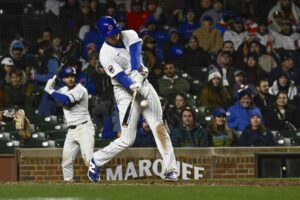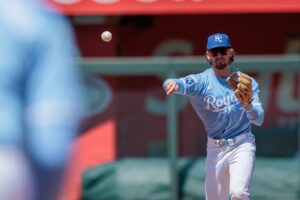Angels Catchers Are Off to a Hot Start
Over the past several seasons, the Los Angeles Angels have seen a revolving door of catchers behind the plate including Carlos Perez, Martin Maldonado, Jonathan Lucroy, and Kevan Smith. Neither Smith nor Lucroy made a compelling case for the team’s long-term strategy during the 2019 campaign. Thus, general manager Billy Eppler traded for Max Stassi prior to the 2019 deadline and added Jason Castro during the offseason. Both catchers have strong reputations as defensive catchers. However, their offensive production has captured attention early this season. In particular, Stassi has generated a significant amount of offense for the Angels lineup. The start to the season may not be what fans had hoped, but the Angels catchers are off to a hot start.
Max Stassi
Defensively
Stassi rates among the best defensive catchers in the majors. Namely, he ranked second overall during 2019 in CSAA at 0.26 (and 0.27 while with the Houston Astros), a popular metric used for measuring effective pitch framing. Further, Stassi ranked fourth in Baseball Prospectus’s TRAA runs. The measure assigns a run value to catchers for their ability to prevent opponent base-stealing attempts.
Offensively
The primary driver for Stassi’s exit out of Houston came from his offensive performance. In 2019, he held a -0.3 WAR with a .136 BA and .378 OPS. His K% rate was over 33% and held only a 5 wRC+ in his time with both the Astros and Angels. However, this season, Stassi is off to a hot start. He already has more home runs so far this season than all of 2019 and five RBI equaling his 2019 totals. He sits at a 0.2 WAR with a 1.076 OPS all while cutting his K% to 11.1% so far this year.
Jason Castro
Defensively
Castro ranks behind Stassi in many of the defensive categories but still lands above the league average. In CSAA runs, he ranks sixteenth at 6.1, just three places behind Stassi at 6.6 in the league. He sits at 26th in the league in both overall CSAA at .009 and a 3.5 FRAA. So far Castro looks good behind the plate and looks to split time with Stassi throughout the season.
Offensively
Among catchers, Castro maintained respectable numbers in 2019. He held a 1.6 WAR and .767 OPS in his time with the Minnesota Twins. Although these do not match his career-high numbers with Houston from 2013-2016, the Angels hope Castro can give the team some much needed offensive production. So far in 2020, Castro holds a 0.6 WAR and a .768 OPS, but his strikeouts and run contributions best reflect his offensive production. So far, Castro has cut his K% by seven percent and his wRC+ has increased by over 20 this season.
Bottom Line
Eppler added Stassi and Castro to add more consistency behind the plate. Considering the youth and struggles of Angels pitching over the past few seasons, Eppler’s preference in adding a veteran signal caller is understandable. The addition of Lucroy in 2019 looked to accomplish that goal, but low offensive production led to his release. Thus, Angels management will be looking for adequate offensive from their catchers.
Fortunately, both players should provide much needed production offensively and defensively. Stassi, in particular, is not known for his offensive production and may be in the midst of a mid-career rebound at the plate. He has hit key home runs in three games that kept the Angels close. Still, the 2020 sample size is small. However, with the Angels stumbling out of the gate, the team will need more surprises from Stassi and Castro to get back into playoff contention.
Main Photo:
Embed from Getty Images






